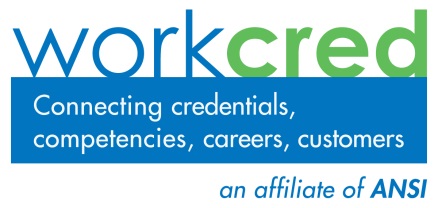From the Item Bank |
||
The Professional Testing Blog |
||
Competencies as a Common LanguageAugust 19, 2015 | |By: Roy Swift, Ph.D., Executive Director, Workcred – an affiliate of the American National Standards Institute (ANSI)
Credentials hold the power to build education and career paths. But the last decade has seen enormous growth in the number and variety of labor market credentials – college degrees, educational certificates, industry certifications, occupational licenses, and micro-credentials such as badges. This growth has fueled confusion among students, workers, job seekers, and employers who are left to navigate the “credentialing maze” without a guiding compass. Students, job seekers, and workers struggle to determine if a credential will get them where they want to go, if they have to renew it and how often, and whether it will be a stepping stone to higher-level credentials. At the same time, employers want to know what competencies a credential holder has, how it compares to other credentials, and how much to trust the claims made. Transcripts with courses, grades, and credits and resumes that list “activities and experiences” are no longer adequate. The lack of transparency in the credentialing market has created a buyer-beware environment. The wide variety of approaches and languages currently used by higher education institutions and industry certification bodies to describe credentials makes it nearly impossible to understand and compare them. Like a box of assorted chocolates, you never know what you are going to get! Competencies are the common currency through which credentials can be evaluated. It is only through transparent competencies that one is able to efficiently stack credentials and navigate a career pathway within or across industries. When competencies are measurable, it becomes clearer what assessments have to be conducted to determine if knowledge and skills have been acquired. Anyone can write a competency statement, but it is only helpful to consumers if it has been validated to the population served, written so it is measurable, and assessed according to the knowledge and skills that support the competency. The problem is that the word “competencies” is used and interpreted so differently by various audiences that it has completely lost its meaning. A common language for describing this and other key features of credentials is sorely needed to bring clarity to the labor market. How else will we know what knowledge and skills stand behind a credential, how a B.S. in computer science from one university compares to another, what two years of military training is worth, or how to compare two or more certifications that say they certify individuals in the same occupation such as cybersecurity? A transparent credentialing marketplace – one that all users can understand and use effectively – is the vision that drives the Lumina Foundation-funded Credential Transparency Initiative. Led by George Washington University’s Institute of Public Policy (GWIPP), Workcred – an affiliate of the American National Standards Institute (ANSI), and Southern Illinois University (SIU), the initiative will develop common terms for describing key features of credentials – such as competency development and validation, assessment system, among others – to enable common understanding of these terms and in turn, a more informed market. The initiative will build and test a first-of-its kind Credential Registry and related apps that will allow users to compare the quality and value of workforce credentials using a web-based system with information provided directly by the institutions issuing the credentials. The goals are transparency and clarity, and to help align credentials with the needs of students, job seekers, workers, and employers. All Americans have a stake in a strong and effective labor market credentialing system, and Workcred is proud to be part of this exciting partnership. After all, when it comes to building a competency-driven, workforce credentialing ecosystem, strong partnerships are what are going to get us there. The labor market is in constant flux. To keep pace, we need to leave the Tower of Babel behind and start speaking the same language. Workcred challenges the three pillars of the U.S. credentialing system – educational institutions, industry, and credentialing organizations – to come together and collaborate on building a credentialing ecosystem based on valid, clear, assessable competencies that are updated on an ongoing, systemic basis so as to keep in stride with market needs. Categorized in: Industry News |
||



Comments are closed here.